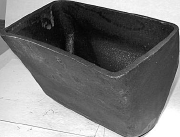Rugged building Type “MD” Buckets are most preferred for standard function elevators. Covering a wide choice of sizes from 4 to 20 inches long, they are really utilized for ?ne and medium size products such as coal, cement, pulp, grain, ear corn,  and so on. They are broadly applied for heavy abrasive materials such as sand, gravel, and stone. Reinforced front lips give Design “MD” Buckets an extended sporting digging edge. Uniform wall thickness and solid corner reinforcement make them more powerful than steel buckets with the exact same gauge.They are smoothly surfaced and also have ends sloped inward at six degree angles to insure correct ?lling and clean discharge. Available in Malleable and Al-lied-Locke Promal.
and so on. They are broadly applied for heavy abrasive materials such as sand, gravel, and stone. Reinforced front lips give Design “MD” Buckets an extended sporting digging edge. Uniform wall thickness and solid corner reinforcement make them more powerful than steel buckets with the exact same gauge.They are smoothly surfaced and also have ends sloped inward at six degree angles to insure correct ?lling and clean discharge. Available in Malleable and Al-lied-Locke Promal.
Chain for which buckets can be found in-clude: Steel Bushed Roller, Steel Bushed, Combination, “H” Class Mill, 400 Class Pin-tle, and 700 Class Pintle. “MD” Buckets are employed with G1, G6, K1, or K2 design attach-ments after they can be found from the chain type.
Capacities are for buckets ?lled for the line XX (see diagram). The sensible working capability will fluctuate using the loading problems, angle of re-pose of the material staying dealt with, as well as the incli-nation of the elevator.
Style “AC” ELEVATOR BUCKETS for handling cement, lime, and ?uffy supplies
Fashion “AC” Buckets provide speedy, thorough discharge of cement, lime, and other dry, ?uffy resources. Vent holes during the bottom of every bucket release trapped air in ?lling and allow material to empty from bucket rapidly and completely on discharge. Moreover to reinforcing lips, hooded backs reinforce “AC” Type Buckets. This attribute permits closer bucket spacing and gives 30% greater carrying capacity than other bucket types of the same length. These sturdy buckets have an extra thickness of metal at put on points for longer service. Available in Al-lied-Locke Malleable and Promal.
Type “AC” Buckets are often applied with hefty duty engineering chain such as Bushed Steel Chain with K2 and K3 type attachments.
Capacities are for buckets ?lled to either line XX or YY (see diagram). The useful operat-ing capacity will differ with loading conditions, angle of repose from the material currently being handled, as well as inclination from the elevator.